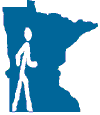What were things like in 2002?
The following idicator summary is from the 2002 Minnesota Milestones and does not neccessarily reflect the current data trends.
Indicator : Eighth-grade basic skills
Rationale: The statewide Basic Standards Tests are designed to measure essential abilities needed to live and work in today's society.
About this indicator: Eighth-graders have shown dramatic improvement on these tests since their inception in 1995-96. Four out of five eighth-graders passed the reading test in 2001-02, compared to just over half in 1995-96. In mathematics, the pass rate improved from 69 percent in 1995-96 to 75 percent in 2001-2002. When the Basic Standards Tests first began, students had better success on the math test, however reading scores have made greater improvement in recent years.
These results show how many students pass the tests the first time, in the eighth grade. Those who do not pass can repeat the tests once a year through twelfth grade. They must pass in order to graduate from a Minnesota public high school. The difficulty level is considered equivalent to reading a newspaper and doing pre-algebra math.
The numbers here include most special education students and students with limited English proficiency who also take the tests. Accommodations, such as extra time or use of a computer, may be made for students with special educational needs. In reality, a minuscule number of Minnesota students do not graduate because of failing the Basic Standards Tests. Schools must provide help for students who otherwise might be unable to pass the test.
For comparison: The closest national benchmarks are the National Assessment of Educational Progress eighth-grade mathematics and reading tests. These assess the same skills, but at a higher level of competency. In the 1998 reading test, 37 percent of Minnesota students scored “proficient” or better, compared with 30 percent nationally, ranking Minnesota fourth among 36 participating states. In the 2000 mathematics test, 39 percent of Minnesota students scored proficient or better, compared with 26 percent nationally, placing Minnesota first among the 40 participating states.
Things to think about: A big gap remains between pass rates in the central cities and the rest of the state. In 2001-02, 48 percent of Minneapolis eighth-graders passed the math test; 53 percent passed the reading test. Forty-eight percent of St. Paul eighth-graders passed the math test and 55 percent passed in reading. However, the gap is narrowing slightly because of improvement in both districts.
There are differences statewide between lower-income and higher-income students on the basic standards tests, but this is more evident in St. Paul and Minneapolis. According to analysis by the Wilder Research Center, in the central cities higher-income students were about twice as likely to pass the test. Lower-income students fare better in the suburbs than in the central cities. Passing rates also differ by race: white students have the highest pass rate, black students the lowest. The differences in race are related to, but not fully explained by, family income levels.
Technical notes: Eigth grade Basic Skills tests were phased in during 1996 and 1997, when 78 percent of 8th graders participated. Since 1998, all students are required to take the tests. A score of 75 percent is required to pass the Basic Standards Tests. There is also a Basic Standards Test in writing that students must pass in order to graduate. That test begins in the tenth grade.
Sources:Minnesota Department of Children, Families & Learning, http://cfl.state.mn.us/ Wilder Research Center, Metro Trend Watch 2001, www.metrotrendwatch.orgU.S. Department of Education, National Assessments of Educational Progress, www.nces.ed.gov/nationsreportcard
Related 2002 Milestones indicator:
Other related indicators:
- School attendance rates (Minnesota Department of Children, Families & Learning, http://cfl.state.mn.us)
- U.S. fourth-grade scores in reading and math (U.S. Department of Education, National Assessment of Educational Progress, www.nces.ed.gov/nationsreportcard)
- Public school students by race and ethnicity (Minnesota Department of Children, Families & Learning, http://cfl.state.mn.us)
- Language spoken at home (Minnesota Department of Children, Families & Learning, http://cfl.state.mn.us)
Local data:
School district level data:
County level data:
School district level data:
County level data:


Milestones is a product of the Minnesota State Demographic Center, a division of the Department of Administration





